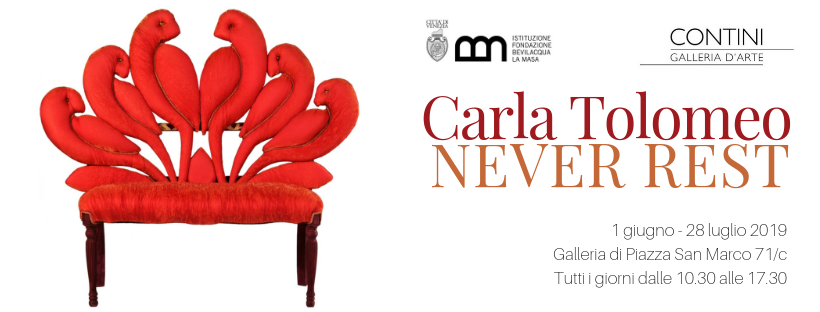Venice, Carla Tolomeo's chair-sculptures at the Fondazione Bevilacqua La Masa
From June 1, 2019, the Bevilacqua La Masa Foundation in Venice, in collaboration with the Contini Art Gallery, will host the solo exhibition of artist Carla Tolomeo (Pinerolo, 1941) entitled Never Rest. Carla Tolomeo, a multifaceted artist active on both the national and international scene, was trained in Rome as a painter under the aegis of Giorgio De Chirico and, later, the masters Renato Guttuso, Franco Gentilini and Ugo Attardi, and finished her artistic education in Milan, bringing to full maturity a style that combines painting, engraving, sculpture, ceramics and design.
He received his first European recognition at the international exhibition D’Après, held in Lugano in 1971. From that time on, his activity takes place mainly in Europe: Vienna, Luxembourg, Geneva and Athens are just some of the most significant stages that followed between 1976 and 1980. The intense pictorial production of these years was accompanied by teaching printmaking at theBrera Academy and Venice and an intense study of the great literary classics and Japanese painting, with particular attention directed toward the work of Kitagawa Utamaro.
This composite training culminates in 1997 with the creation of the first objets d’art or, as Ptolemy herself likes to call them, her “Chair-Sculptures.” The inspiration of the Japanese and metaphysical style of her early training, the influence of the writings of Jorge Luis Borges, among which the Handbook of Fantastic Zoology stands out prominently, and the admiration for the exemplary Catalan modernism of Gaudí, find a common and unifying ground in the artist’s childhood memories. The result is an art form that seeks to synthesize the different souls and, at the same time, the personal history of its creator.
Ptolemy’s creative process begins with the recovery of an antique chair, whose disused wooden frame is personally worked on by the artist until she obtains a backrest with phantasmagorical shapes. Once the “blank canvas” has been obtained on which to work, the phase of researching and choosing fabrics begins, which the artist equates with the selection of colors in painting. In passementerie, brocade, moire, satin and Indian fabrics, Ptolemy’s chairs are no longer mere objects of furniture, but sumptuous thrones that seem to be able to elevate those who sit in them to a dimension of totemistic immersion with nature and life.
For all information you can click here.
Source: release
 |
| Venice, Carla Tolomeo's chair-sculptures at the Fondazione Bevilacqua La Masa |
Warning: the translation into English of the original Italian article was created using automatic tools. We undertake to review all articles, but we do not guarantee the total absence of inaccuracies in the translation due to the program. You can find the original by clicking on the ITA button. If you find any mistake,please contact us.



























